The Villiers Engineering Co. Ltd.
Bond Minicars and others
Villiers engines were used in many motorcycles and in such things as motor
mowers and invalid carriages. They were also used occasionally in
light weight cars. At least some of them are listed here.
Most of this information comes from the amazingly
comprehensive 3wheelers web site, by kind permission
of the site owner, Elvis Payne. His site contains more information
about the Villiers-engined cars listed here and very many other 3
wheelers.
The information and photos on this page about Bond cars all
came from the "Know Your Bond
Minicars
website", by kind permission of the site owner, Rick Smith. Visit
Rick's website at
http://www.g7vyi.me.uk/bond.htm.
(Some of the photos below came to us without a provenance.
Anyone claiming an interest in them, please contact the curator via email).
|
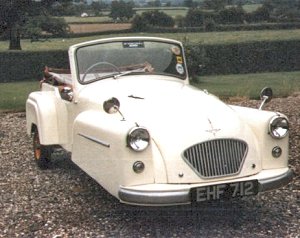
A Mark 'D' Bond minicar. |
The first Bond minicar was the Mark 'A', which came on the
market in 1949. They were powered by 125cc or 197cc Villiers 10D
or 6E engines. The Mark 'B' appeared in June 1951, with
various improvements but the same engines.
The Mark 'C' was launched in January 1953 which used the 197cc 6E.
Later models of this mark had the 8E. |
| In May 1956 the Mark 'D' arrived and its 9E engine was
considered to make a distinct improvement. Electric starting was
an option on this model, but with kick starting retained for
emergencies. Prior to this model starting had been by hand pull
inside the car.
The Mark 'E' saw considerable changes and
the Villiers engine was now considered one of the car's weakest point. |
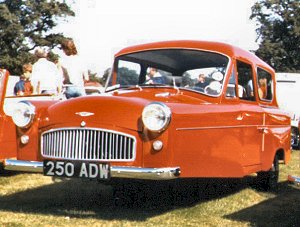
A Mark 'G' Bond Minicar. |
|
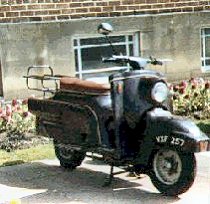
The Bond P1 Scooter.
|
Another Bond Venture was the P1 Scooter. It was
introduced in 1957. It used a 150cc Villiers engine. The P2
had a 197cc Villiers engine. In 1959 the scooter was restyled as
the P3 with the 150cc engine and the P4 with the 197cc engine. So in
November 1958 the Mark F was introduced with the new Villiers 31A 250cc
engine.
This engine gave the vehicle a top speed of 55 mph. The
last of the Bond minicars was the Mark G, introduced in 1961. The
Villiers engines used were the 35A 250cc and, later, the 4T 250cc
twin. The last Mark G was produced in 1966. Later Bond cars did
not use Villiers engines. |
| The Bond 'Minibike' introduced in
1950, also had a Villiers engine. |
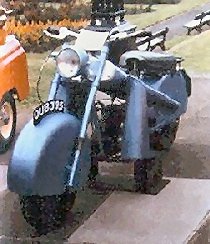 |
AC

The AC Petite. |
AC did not only make muscle cars like
the Cobra and the AC - in fact they started out in 1908 making a 3
wheeler delivery vehicle. In 1953 they produced the AC Petite, a
three wheeler not dissimilar in general appearance to the Bond.
It
was powered by a 346cc single cylinder two stroke Villiers engine.
The cars did not sell very well and were discontinued in 1958.
AC also made invalid cars with Villiers engines. |
ARGSON
| During the late 30s and early 40s the Stanley Engineering
Co. Ltd. of Edham, Surrey, produced an invalid carriage. The petrol driven
version was powered by a 2-stroke Villiers engine. It was sold as the
Argson Runnymede, that being the name of the vehicle originally designed in
South Africa. |
FRISKY
| Henry Meadows' Frisky was powered by a 197cc Villiers
engine.

|
Take a look at the Frisky display in
the museum |
|
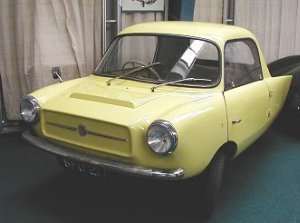
The Frisky in the Black Country Living Museum. |
HARPER
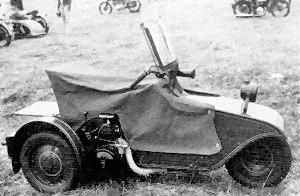
The Harper. |
The Harper was made by the well known body builders, A.
V. Roe & Co. Ltd. of Manchester.
The Harper Runabout was first
made in 1921 and had a 269cc Villiers engine. It carried two
people sitting, in tandem, of motor cycle seats. Production
stopped in 1926. |
SCOOTACAR
The Hunslet Engineering Co. of Leeds
produced the Scootacar in 1958 and production continued until 1965, the
vehicle going through 3 marks in the process.
The first two used
197cc Villiers engines, and the mark 3 had a 324cc engine. It was
a two seater in the style of a bubble car. |
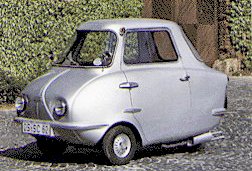
The Scootacar. |
XTRA
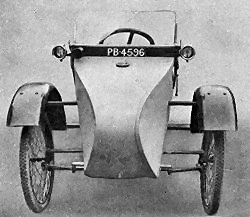
The Extra. |
The Xtra Cyclecar was made between 1922 and 1924 by Xtra
Cars Ltd. of Chertsey, Surrey.
It was a single seater, with two
wheeles at the front and one at the back, and "largely resembled a
3-wheeled sidecar".
It used a 3.75 hp Villiers engine. |
INVACAR
The original Invacar (a car designed for
people with a physical disability which precluded their driving an
ordinary car) was designed by Oscar Greeves and produced by his company
Invacar Ltd., which was founded in 1948. His vehicle was powered
by a Villiers 147cc engine. These vehicles were bought by the Ministry of Health which leased them
out to whoever they thought were deserving cases. |
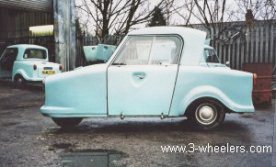
An Invacar. Photo courtesy of Elvis
Payne. |
|
They also bought similar vehicles from other
makers, including Harding Ltd., Dingwall & Son, AC Cars, Barret Tippen &
Son, Coventry Climax and Thundersley.
In the 1950s the Ministry decided that it would only provide
cars built to their standards, so that people needing these cars had a
choice: take it or leave it. The Ministry specification required a
Villiers 147cc engine to be fitted and this continued until Villiers stopped
making the engines.
|
 |
|
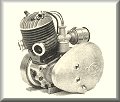 |
|
 |
| Return
to Adverts |
|
Return
to the
beginning |
|
Proceed
to
Starmaker |
|